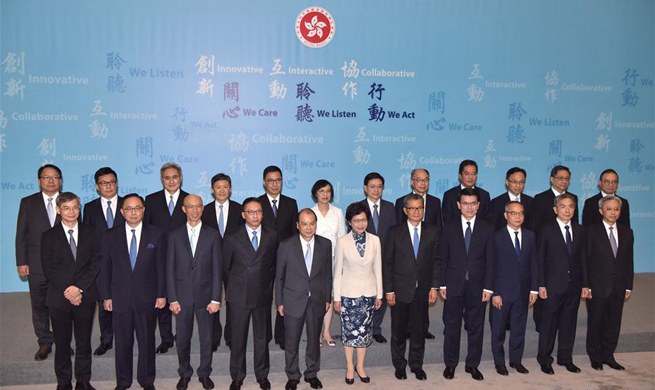By Tao Jun, Bui Long
HANOI, June 22 (Xinhua) -- The Vietnamese government has insisted on not lowering the 6.7 percent economic growth target set earlier this year, but local and foreign experts have told Xinhua that realizing it might be somewhat challenging.
At the month-long third session of the 14th National Assembly, Vietnam's top legislature, which concluded on Wednesday, the government showed strong determination to realize the target of a 6.7 percent increase in the country's gross domestic product (GDP) this year. Its GDP growth last year was 6.21 percent.
The Economic Commission under the Communist Party of Vietnam Central Committee said that, to achieve the difficult goal, Vietnam has to post an average economic growth of over 7 percent in the remaining quarters of this year, since GDP grew only 5.1 percent in the first quarter.
According to the commission, bank loans should be focused on production, not real estate, and access to loans with suitable interest rates would be widened for enterprises.
In addition, monetary and fiscal policies should be aimed at stabilizing inflation, regulating foreign exchange rates reasonably, reducing state budget overspending, lessening public debt pressure, and improving loan-using effectiveness.
Vietnam will center on macroeconomic stabilization, controlling inflation, recovering tax arrears, attracting more foreign investment, accelerating administrative reforms, and boosting tourism development, Permanent Deputy Prime Minister Truong Hoa Binh said at the session.
In a meeting on GDP acceleration earlier this month, Deputy Prime Minister Trinh Dinh Dung stated: "It is very difficult to realize the 6.7 percent economic growth target set for this year, but it is not unattainable."
Dung instructed the Ministry of Planning and Investment from now to the end of the year to ensure the realization of specific targets set for every key component that contributes most to GDP.
He also instructed the Ministry of Industry and Trade to further assist enterprises in developing both local and foreign markets, effectively tap already-signed free trade agreements, and actively cope with technical barriers and protectionist trends in the world.
The Ministry of Industry and Trade has been tasked to ensure the domestic garment and textile, footwear and bag sectors, grow over 10 percent this year, while increasing the automobile sector's local content rate, and prioritizing the production of phones, electronics components and construction materials.
Vietnam is striving to pump out an additional 1 million tons of crude oil and 1 million cubic meters of natural gas, raising the total to nearly 13.3 million tons of oil and 10.6 billion cubic meters of gas this year.
In spite of hailing the government's strong determination, some experts and organizations in Vietnam have expressed their concerns that the 6.7 percent target will be unattainable if no drastic measures are taken, or unless measures are taken but with focus on tapping natural resources such as oil and gas.
MarketIntello Vietnam, a leading market research company based in Hanoi, told Xinhua on Wednesday that one of the short-term solutions of the Vietnamese government to support economic growth is to extract an additional 1 million tons of crude oil for exports and production. This plan could be feasible if crude oil prices rebound, the market research form said.
However, "in a scenario where crude oil prices remain at low prices, the exploitation of crude oil for sale could lead to losses for the stakeholders," MarketIntello Vietnam stated, noting that the diplomatic crisis between Qatar and other Gulf states has affected the recovery of global crude oil prices, indirectly affecting the Vietnamese government's plan to exploit an additional 1 million tons of oil.
According to the Ministry of Planning and Investment, the cost of exporting a barrel of oil in Vietnam is about 30-70 U.S. dollars. PetroVietnam Oil Corporation's capital recovery cost is about 50 U.S. dollars per barrel, according to the Ho Chi Minh Securities Company. That the crude oil prices have remained below 50 U.S. dollars per barrel in recent times poses challenges for the government to pursue the plan.
Nguyen Duc Thanh, President of the Vietnam Institute for Economic and Policy Research, shared similar views.
He said that a short-term mindset in dealing with the slowdown in growth such as efforts to increase capital, accelerate the disbursement of public projects and the extraction of crude oil may slow down the forces behind reforms, leading to a delay in the recovery of sustainable growth.
MarketIntello Vietnam said that the optimism of some manufacturers about the prospects of the current production situation will also affect the government's growth plan.
Although the recovery of industrial production in the last two months was positive, it did not help industrial production growth in the first five months to achieve the growth of the same period last year.
The Purchasing Managers' Index (PMI), an indicator of the economic health of the manufacturing sector, still declined.
"This decline may affect the Industrial Production Index in the following quarters," said the market research company.
According to Vietnam's General Statistics Office, the industrial production index grew 5.7 percent in the first five months of this year, but was still lower than the 7.4 percent increase logged in the same period a year earlier.
"Vietnam's economic growth in 2017 is expected to reach 6.1 percent," MarketIntello Vietnam said, noting that its inflation is predicted to stand at 2.9 percent.
Meanwhile, the Vietnam Institute for Economic and Policy Research said the country's GDP is likely to gain 6.37 percent, and see its inflation rate hit 2.35 percent this year. If the growth of 6.7 percent is attained as outlined, inflation will increase to 3.2 percent, the institute forecast.
However, the institute pointed out four macroeconomic challenges faced by Vietnam.
Firstly, signs of dependence on the foreign direct investment sector in import-export activities have been increasingly clear, thus the domestic manufacturing sector has been becoming weaker and weaker in the expanding process of international integration.
Secondly, the budget deficit and public debt still mean the country is under threat of macroeconomic risks.
In addition, the share of spending on development investment has been on a downward trend, leading to negative impacts on medium and long term development.
Finally, the U.S. Federal Reserves' interest rate hikes and U.S. economic policies could affect Vietnam and have negative impacts on exports and exacerbate the trade deficit next year.
Therefore, regarding short-term policies, Vietnamese policymakers need to be cautious about adjusting monetary policy, and particularly careful and independent in adjusting credit growth policy to steadily maintain the inflation target.
Moreover, the government needs to seriously implement the policy on staff cuts and cutting down on recurrent expenditures and financial support for budget-funded activities of various associations, said the institute.
Concerning long-term policies, to continue "enjoying a level of stability that many countries in the region envy," Vietnam should effectively handle "continued challenges dealing with corruption, human resource constraints, and an overly-complicated, restricted, and unclear licensing and regulatory environment," Adam Sitkoff, Executive Director of the American Chamber of Commerce in Hanoi, told Xinhua recently.
"The recovery of the global economy, from the United States to Europe and China will be a good opportunity for Vietnam to increase exports. This will be an opportunity for Vietnam to improve its trade balance in the rest of the year," MarketIntello Vietnam said.

















